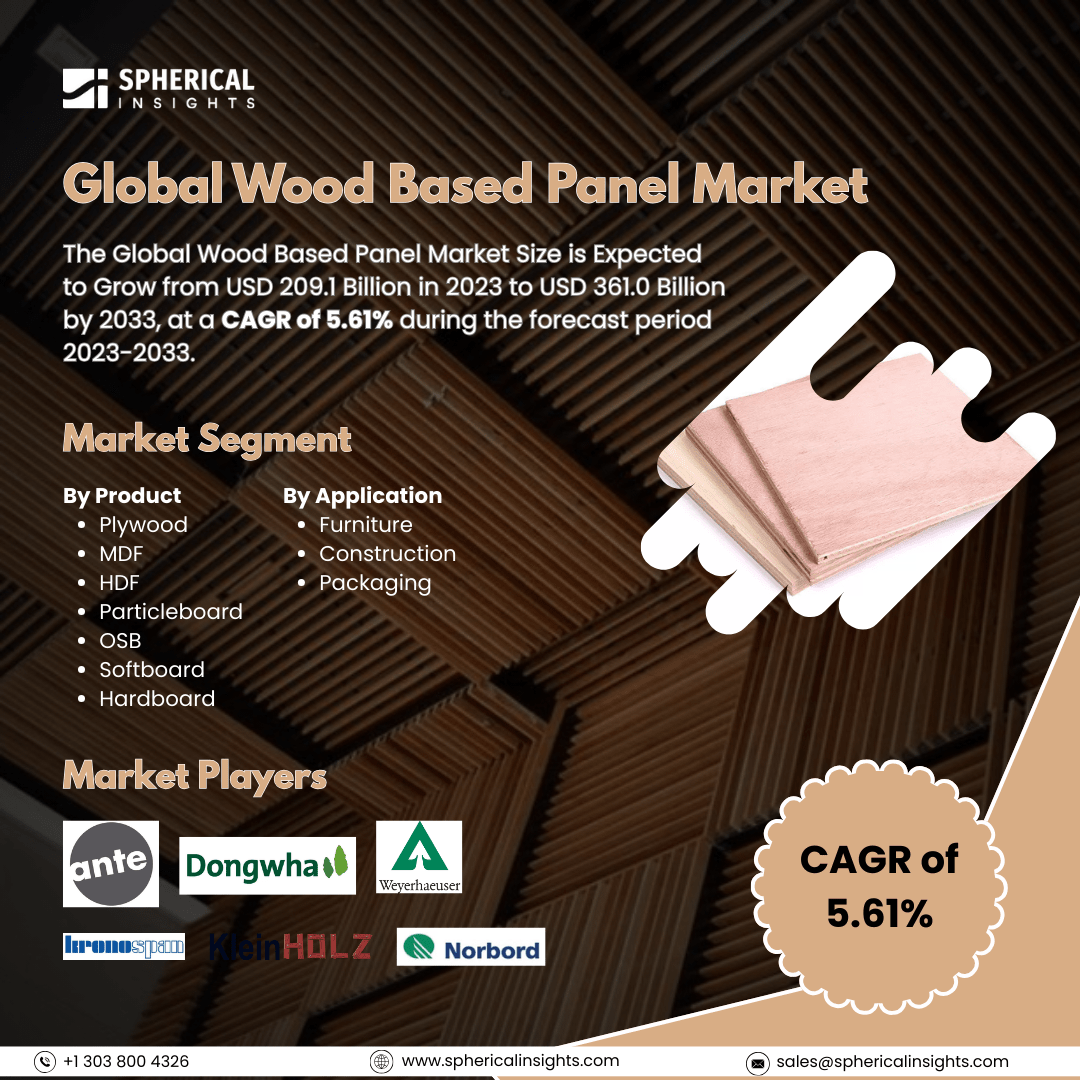Global Wood Based Panel Market Size to worth USD 361.0 Billion by 2033
According to a research report published by Spherical Insights & Consulting, The Global Wood Based Panel Market Size is Expected to Grow from USD 209.1 Billion in 2023 to USD 361.0 Billion by 2033, at a CAGR of 5.61% during the forecast period 2023-2033.
Browse key industry insights spread across 210 pages with 110 Market data tables and figures & charts from the report on the Global Wood Based Panel Market Size, Share, and COVID-19 Impact Analysis, By Product (Plywood, MDF, HDF, Particleboard, OSB, Softboard, and Hardboard), By Application (Furniture, Construction, and Packaging), and By Region (North America, Europe, Asia-Pacific, Latin America, Middle East, and Africa), Analysis and Forecast 2023 – 2033.
The industry that produces, distributes, and uses engineered wood products manufactured from wood fibers, strands, or veneers joined together with adhesives is known as the global wood-based panel market. These panels are widely utilized in flooring, furniture manufacture, construction, and packaging because of their strength, durability, and affordability. Urbanization and construction activities worldwide, especially in emerging economies, are driving the demand for wood-based panels due to their durability, aesthetic appeal, and ease of installation. The increasing preference for sustainable and eco-friendly materials is driving market growth. Wood-based panels are renewable, recyclable, and align with green building practices. Innovations in manufacturing processes and adhesive technologies enhance their efficiency and performance. The growing trend of home renovations and furniture spending also drives the demand for wood-based panels, which are considered environmentally friendly alternatives to traditional building materials. However, advanced manufacturing technologies' high initial costs and long production cycles can hinder market growth, particularly for smaller manufacturers, making investment challenging.
The plywood segment accounted for the largest share in 2023 and is expected to grow at a significant CAGR during the forecast period.
Based on the product, the wood based panel market is classified into plywood, MDF, HDF, particleboard, OSB, softboard, and hardboard. Among these, the plywood segment accounted for the largest share in 2023 and is expected to grow at a significant CAGR during the forecast period. Plywood is gaining popularity due to its strength, versatility, and durability. As urbanization accelerates, especially in emerging economies, demand for plywood in construction applications like flooring, roofing, and wall sheathing increases. Its resistance to moisture and fire makes it a preferred choice for structural projects. Infrastructure development further drives this demand.
The furniture segment accounted for the highest market share in 2023 and is expected to grow at a substantial CAGR during the forecast period.
Based on the application, the wood based panel market is divided into furniture, construction, and packaging. Among these, the furniture segment accounted for the highest market share in 2023 and is expected to grow at a substantial CAGR during the forecast period. The furniture market is expanding due to rising consumer demand for durable, aesthetically pleasing products. Materials like MDF and particleboard are preferred for their affordability and smooth surfaces. The trend towards sustainable furniture and home renovation projects are also driving growth in eco-friendly wood-based panels.
Asia Pacific is estimated to hold the largest share of the wood based panel market over the forecast period.
Asia Pacific is estimated to hold the largest share of the wood based panel market over the forecast period. Rapid urbanization and increased disposable income are driving market growth in wood-based products in construction and furniture manufacturing. Consumers seek durable, aesthetically pleasing materials. Infrastructure investments in India and Indonesia enhance market potential. Home renovations also contribute to the increased consumption of wood-based panels in residential settings.
North America is predicted to have the fastest CAGR growth in the wood based panel market over the forecast period. The construction sector is thriving due to consumer interest in sustainable materials and wood-based products. The region's strong housing market drives demand for plywood and engineered wood products. The expansion of e-commerce enhances distribution channels, further supporting market growth. The focus on eco-friendly practices and renovations drives demand for these materials.
Company Profiling
Major key players in the wood based panel market include Ante Group – Germany, Donghwa Group - South Korea, Klein Holz AG, Kronospan, Caihong Wood Co, Weyerhaeuser Company and Norbord, and Others.
Recent Development
- In May 2024, the Island City, Oregon-based particleboard plant owned by Woodgrain was acquired by Kronospan. The goal of this calculated action is to increase Kronospan's market share in the wood-based panel industry in North America. With an emphasis on the long-term advantages for stakeholders, CEO Hans Obermaier expressed excitement about integrating the skilled workers from the Island City factory.
Key Target Audience
- Market Players
- Investors
- End-users
- Government Authorities
- Consulting And Research Firm
- Venture capitalists
- Value-Added Resellers (VARs)
Market Segment
This study forecasts revenue at global, regional, and country levels from 2023 to 2033. Spherical Insights has segmented the wood based panel market based on the below-mentioned segments:
Global Wood Based Panel Market, By Product
- Plywood
- MDF
- HDF
- Particleboard
- OSB
- Softboard
- Hardboard
Global Wood Based Panel Market, By Application
- Furniture
- Construction
- Packaging
Global Wood Based Panel Market, By Regional Analysis
- North America
- Europe
- Germany
- UK
- France
- Italy
- Spain
- Russia
- Rest of Europe
- Asia Pacific
- China
- Japan
- India
- South Korea
- Australia
- Rest of Asia Pacific
- South America
- Brazil
- Argentina
- Rest of South America
- Middle East & Africa
- UAE
- Saudi Arabia
- Qatar
- South Africa
- Rest of the Middle East & Africa



